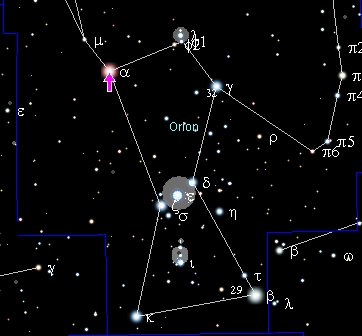 Every now and then, I spot a sudden influx of new readers searching for a specific topic on the website, today there seems to be a lot of you looking for “betelgeuse star”. I assume, an astronomy or science class asked a question on the subject or set a homework assignment and that Sciencebase comes up in the search engines as a place to go for more information.
Every now and then, I spot a sudden influx of new readers searching for a specific topic on the website, today there seems to be a lot of you looking for “betelgeuse star”. I assume, an astronomy or science class asked a question on the subject or set a homework assignment and that Sciencebase comes up in the search engines as a place to go for more information.
Betelgeuse (Alpha Orionis), is the eighth brightest star in the night sky and second brightest star in the constellation of Orion, outshining its neighbour Rigel (Beta Orionis) only rarely. It sits at the point you might consider to be Orion’s right shoulder assuming he’s facing Earth, as it were. The star has a distinct reddish-tint (mentioned by Ptolemy the first century AD) and its apparent magnitude varies from 0.2 to 1.2 (the most variable brightness for a first magnitude star).
Betelgeuse is a red supergiant, which if it sat at the centre of our solar system instead of the Sun would engulf all the inner planets and beyond the asteroid belt, perhaps even stretching as far as the orbit of Jupiter or beyond. Astronomers estimate that Betelgeuse is just 10 million years old but evolved rapidly because of its high mass. You can read more on Wikipedia.
There’s a lovely video showing the stellar scale heirarchy. Betelgeuse is enormous (400 million km diameter) compared with the Sun (1,392,000 km diameter), almost as big as Antares (600 million km) but a lot smaller than the red hypergiant VY Canis Majoris, which is about about 3000 million kilometres in diameter.